- Main article: Planetary Industry
High Sec has different rules than Lower Sec. One of them is how to do PI.
In Lower Sec Space one extracts P0 from the Planet (Aqueous Liquids) and sends it through Factories to produce P1 (Water). Possible production of P2 or P3 can also take place. This is considered passive, and involves minimal time to manage. Minimal time is minimal ISK. In High Sec planets are less productive at P0, and the math implies to make P3 or P4.
P4 is a great deal more time, and riskier. There is Price Risk, that is the risk from buying from the market and selling in the market. There is Tax Risk, that is the prices one pays to import and export through the Customs Office. There is Combat Risk, that is pirates / players / Trigs potentially disrupting your haulers flight path. Increased risk is increased profits, and there is a reward worthy of the committed.
Increasing Risk & Time is Rewarding for those that opt-in.
If you choose to try to make P4, it would be wise to upgrade BPO's that utilize what you plan to make for the goal of producing out sized profits. Standup, Station, Mobile, and Structure are the key words to search out for the potential to make those big profits.
EVE Industry - Blueprint Calculator (eve-industry.org) is an excellent BPO price estimator. They should overestimates taxes, and assumes all materials are bought and sold at Jita. EVE-Cost - Manufacturing Calculator may be better. Often the price is lowest at Jita for raw materials compared to other Trade Hubs. P1 is cheap, P4 is not. Use BPO's to consume P4 to Produce Finished Goods, and sell it at other Trade Hubs for a great deal more. P1 bought at Jita used to produce modules sold outside of Jita can generate large profits. Janice - Price check is the selling price estimator I use to pick which Trade Hub gets which goods to sell.
The potential for a 24 hour period to import P1 and produce P4 is about 10 units of P4. You can do the math to see if a BPO is too much time to produce the P4 for the potential profit. Mobiles use the least amount of raw materials. One can always sell the P4 at market, and it can be profitable enough to minimize the time sink at making Isk.
Stay safe, and Print that Isk!!
To properly set up a P4 planet there are only 2 Planet Type Options - Barren or Temperate. Ideally a pilot should look for 6 Planets in the same system, or close together, for the two planet types that can make P4. Take note of the Tax Rates by inspecting the Customs Office in orbit. Factors to consider are the distance from the nearest Trade Hub, and Safety. The P1, Raw Materials, will need to be delivered to a station close by from a Trade Hub, and time is Isk.
Every planet needs a fully Upgraded Command Center, Launch Pad, 2x Warehouses. A pilot sets up 2 Warehouses to reduce problems with depositing the P1 and storing the P2-P4 until a pilot is able to transport Finished Goods off planet. Pilots can deliver more often than they can pick up. A Warehouse stores 12,000 m^3, and the Launchpad can hold 10,000m^3. A pilot can deliver at most 10,000m^3 to a planet's warehouse within roughly a 16 hour cooldown timer. This is due to the 10,000m^3 limit in the Launchpad. Each tier reduces volume of products at every step in the manufacturing process. Exports are significantly smaller volume than a pilot delivers, and only occasional exports will need to happen due to the smaller volume.
A pilot needs set up Links between structures to facilitate movement of products between structures. Links are the transportation for the raw materials and finished goods to flow around an outpost. Distance of Links consumes Powergrid and CPU. It is best practices to keep everything close together. The basic outpost should appear something displayed below….
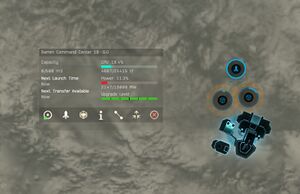
The Initial Set Up - A fully upgraded Command Center, 2 Warehouses, Launchpad
It is very easy to set up the P4 supply chain, but to get it done can take at least an hour. Once an outpost is set up, the only thing a pilots needs to do is move materials between the Launchpad, and Two Warehouses daily.
Place a High Tech Factory first. Then place the Advanced Factories to produce P3 required by the P4 factories. Set up Routes. Some P4 needs a bit of P1 in addition to P3.
Use Links to set up Routes between the Factories and Warehouses. Always set up routes between the Factories and Warehouses, never Factory to Factory. The Factories need a buffer, and the large space of a Warehouse supplies flexibility so that no resource is wasted with no time lost.
After setting up the P3 Advanced Factories, place the P2 Advanced Factories that produce raw materials needed for the P3 Advanced Factories. Link the P1 Raw Materials Warehouse to the P2 Advanced Factories after delivering an initial deposit of P1. Then Route the P2 Advanced Factories output to the (P2-P4) Warehouse. Have all P2-P3 Advanced Factories Route to a P3-P4 Warehouse.
Never route directly from a Factory to a Factory, Complications would cause resources to go wasted. Use a Raw Materials Warehouse to store the P1 and Route to the P2 Advanced Factories, and the P2 Finished Goods to the P2-P4 Warehouse. Use Links to set up Routes between the P4 High Tech Factories and P2-P4 Finished Goods Warehouse. This methodology minimizes the bottlenecks in the supply chain Maximizing efficiency is the goal of any manufacturer. The P2-P4 Warehouse can store variable amounts of the goods. Timing won't be so rigid a potential waste occurs, and factories production maximizes P4 with little time waste.
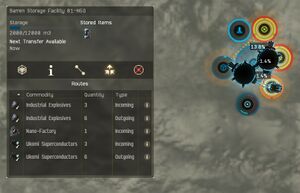
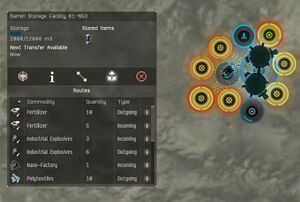
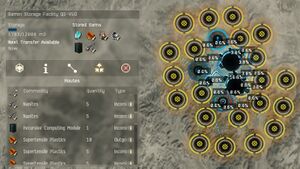
Advanced Factories roughly take Two Cycles (1 hour per cycle) of a lower tier Advanced Factory to produce outputs. If set up properly there will be 28-36 Factories by the time you have maximized the CPU and Power Grid to produce P4. It should take more P2 Advanced Factories than P3 Advanced Factories. Then more P3 Advanced Factories than P4 High Tech Factories. At a minimum it is ideal for 2 Advanced Factories producing each input to be producing for each 1 Finished Goods Output.
Some planets will produce more P4 than other planets since each P4 has variable inputs compared to other P4. Plan ahead at what P4 may produce only small amounts than the other P4 you choose to produce.
It will take over one day after a delivery of P1 to completely consume raw materials P2-P3 to produce the P4. A pilot should be delivering more P1 before the P4 has consumed all the P3. With two Warehouses there will be flexibility in the supply chain. The final outpost should look something like what is pictured below…
You will need to add up the total P1 needed to deposit on outposts for the 1, 2, 3, 5 Day Amounts. The Player Owned Customs Office can fit 3 Days, and 1 Day will fit in the Warehouse. So one deposits 2 Days, move 1 Day over, then move the Second Day, then Deposit the Three Day amounts. That is a total of 5 Days. A pilot only needs to use an hauler to deposit P1 once every 5 Days.
26316 Units of P1 can fit in 10,000m^3. Some P4 needs a P1 combined with two types of P3 to produce. This number is 904 to roughly produce a day's P4. The math looks like below for 1 day of production P4…
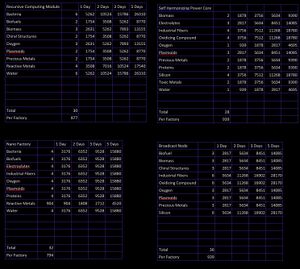
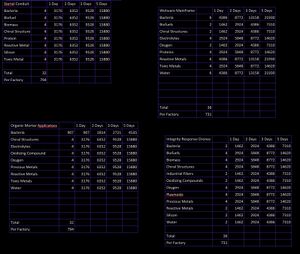
Some P3 is used to make Tech I Modules, and other P3 makes Tech II. The market for Tech I, and is preferable for those that plan to sell. To gauge what a P3 makes, choose the P3, and then check the industry tab after show info is clicked. Tech I modules are made in much larger quantities than Tech II. So to make certain there is a market that will buy from a pilot, P3 should be used in Tech I if maximizing sales is a consideration.
Tech I sourced P3
- Ukomi Superconductors
- Synthetic Synapses
- Supercomputers
- Smartfab Units
- Nuclear Reactors
- High-Tech Transmitter
- Hermetic Membranes
- Guidance Systems
- Gel-Matrix Biopaste
- Data Chips
